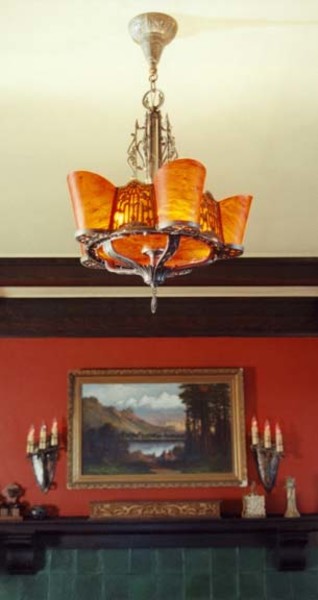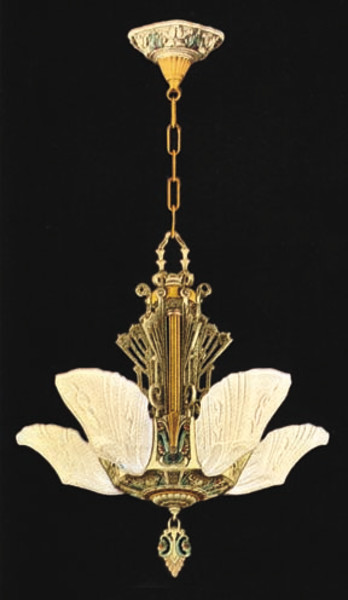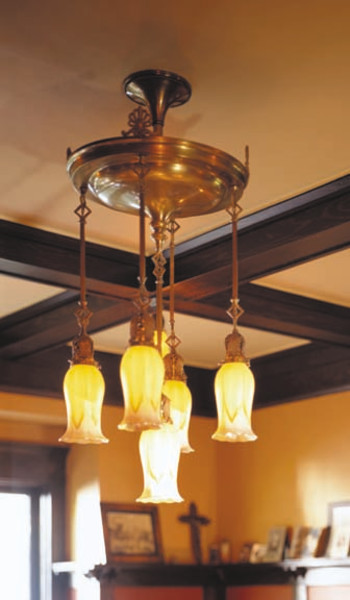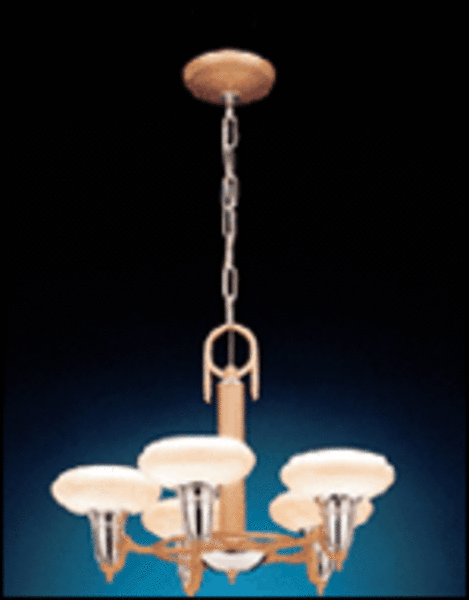Bakelite, the first synthetic resin, found its way into furniture and radios by the late 1920s. Here, it’s seen mimicking then-popular crackled amber glass in an antique chandelier’s shades. (Photo: Courtesy of Luminaria Lighting)
If your old house dates from the years between the wars (alternately known as the Depression Era), determining what kind of light fixtures graced it originally may be baffling. That’s because 1925 to 1940 was a design period that echoed the musical of the day—”Anything Goes.”
Hip urbanites were enamored of Art Moderne, a European design trend (eventually rechristened Art Deco) that deliberately eschewed the past and sometimes mingled with the organic forms of Art Nouveau. More conservative Americans, however, were going retro. Servicemen returning from Europe dreamed of romantic chateaus and thatched cottages. The Colonial Revival and Early American movements were in full swing, yet you could still see flashes of Victorian influence here and there, along with medieval and Mediterranean wrought-iron designs.
If your own architecture reflects any of these styles you should have no problem finding antique or reproduction light fixtures in concert. If it’s more eclectic or bland, one supplier advises, “Buy what you love.”
Technological Advances
At the turn of the 20th century, a family with electric lighting was the envy of its neighborhood. The house was probably adorned with little more than a ceiling fixture for each room, perhaps some brackets or sconces converted from gas, and a few table lamps at the end of long, heavy cords. By 1921, according to the Copper and Brass Research Association, eight million American houses were wired; five years later, the total was nearly 14 million.
By then most new fixtures had “keyless sockets,” meaning that users controlled them at a wall switch rather than at the fixture itself, although you could occasionally still order a fixture with a pull chain. No longer just utilitarian innovations, light fixtures were now marketed to address concerns for both style and health. Without central electricity, Father would have to squint through spectacles at his book while Junior and Sis stared morosely at the fireplace. Adequate lighting let happy homebodies pursue the favored activities of the time: piano playing, card games, knitting, and reading the evening newspaper.
In the mid-’30s, literature from the Lightolier Company warned that “much of the irritability found in so many homes, many nervous or backward children, a great deal of headaches, nervous disorders, and lowered vitality-with its diminished resistance to colds and other ills-can be laid at the door of poor illumination.”
To help consumers avoid eyestrain, sellers distinguished between direct, indirect, and semi-indirect lighting. The Macbeth-Evans Glass Company in Pennsylvania went so far in its 1933 catalog as to publish photometric analyses of each fixture. The company claimed that its shades would eliminate harsh green tints common to pale yellow tinted glass without the heaviness characteristic of amber or etched—just two of the many glass-shade styles available by then.
Slipper shades were a signature Art Deco fixture style, but because each design varied slightly, they can be hard to replace today unless you buy a reproduction. (Photo: Courtesy of Rejuvenation)
A Stylistic Turning Point
Prior to 1925, many light fixtures still bore vestiges of Victorian ornamentation on both frames (the typically metal bodies) and shades (if they had any), since they were often patterned on gas fixtures. Colonial and Early American styles harkened back further, to reindustrialize oil lamps and candelabras. Dining room chandeliers tended to hang from multiple chains, often 3′ long, supporting a central bowl, a “shower” of down-pointing glass shades, or a combination of the two. You could also opt for pendants with a single chain and lamp (bulb).
Many fixtures employed bare lamps early in this period-either shaped as candle flames or plain orbs. Round lamps with a tiny point on top began to fade from the scene about this time. Colonial-style chandeliers and brackets sprouted small, individual fabric shades to reduce glare.
Then in 1925 a world’s fair of art and architecture, the Paris Exposition Internationale des Arts Decoratifs et Industriels Modernes, launched a style that completely broke tradition with the past in its use of sleek, machine-inspired shapes. It was often called Moderne or Modernism—rarely Art Deco, according to one source, until a revival in the 1960s.
While pure modernism was based on linear, functional lines, the French added the floral motifs of Art Nouveau, then American Indian and Egyptian symbols, such as the ziggurat, inspired by the opening of Tutankhamen’s tomb in 1922.
Originally, these fixtures were limited production European models more likely to be seen in commercial structures than houses. In the Depression years, however, the Moderne look revolutionized the design of mass-produced household items, such as radios or lamps, reflecting the American longing for an aerodynamically improved tomorrow. Zigzags and other geometric patterns showed up on book jackets and other printed matter, including lighting catalogs that nevertheless still offered a heavy dollop of fixtures from yesteryear.
The most stunning Deco fixtures had “slip” or “slipper” glass shades, mounted on chandeliers, brackets, and occasionally flush ceiling lights. Slipper shades were well represented in catalogs of the period, although not so often in houses. Today antique slipper chandeliers cost $1,500 or so and it can be next to impossible to replace broken shades. You can buy many styles of slipper fixtures as reproductions.
Other Moderne-style glass shades included the “set back” or “stepped back”—an upside down ziggurat—and “pudding bowl” chandeliers. Luminaries or Luminators (later called Saturn discs) were round or inverted cones with metal rings or louvers intended to give them a space-age look.
By the ’30s Hollywood movies had become a pervasive influence. Apartment dwellers not decorating their living rooms to emulate the sophistication of The Thin Man might be swayed by the exotic locales they saw in pirate and adventure films like Mutiny on the Bounty. Moorish, Spanish, and Egyptian motifs were popular. Sailing ships and birds were recurring themes; one catalog bragged that women invariably went into ecstasies over its reverse-painted parrot shades.
Shower-style chandeliers were popular Victorian fixtures, but were fading from fashion by the mid-1920s. (Photo: Courtesy of Luminaria Lighting)
Flashbacks
While Moderne was embraced by artsy big city dwellers (some called it New York style) and Hollywood denizens went Storybook, many of the upper middle class were still second-or even first-generation Americans. These members of the country club set wanted to cement their place in society by bowing to well-established fashions-something lighting suppliers understood.
Lightolier decorated pages featuring its “Empire” style (“inspired by beauty of the past”) with sketches of men in knee breeches and women in gowns. It described other designs as shining with “the mellow charm of old time oil lamps.”
Colonial Revival fixtures with oil-lamp-style chimneys and wrought- or hammered- iron frames were still big. Intoned the manufacturer: “There need never be any apology for the Early American note in home furnishings. It does not pretend to be something it is not and it has a basic authenticity of design that puts it on an equal footing with more pretentious periods of style.”
Those weary of traditional decoration “yet who have thoroughly disliked the monstrosities that have masqueraded under the title ‘Moderne’ will greet these delightful creations with enthusiasm…The Lightolier staff has been at great pains to see that beauty was not sacrificed to novelty, proportion slaughtered for oddity, or comfort butchered to make a curiosity.”
For most, though, the M-word could do no wrong in ad copy. The Gleason-Tiebout Glass Company of Brooklyn, for instance, hailed the “absence of confining precedent in Modern Art” in its 1930 catalog, which helped make the point by offering 18 types of glass shades. Crystal could be ordered etched, roughed inside or out, frosted, or polished. Cased glass was two or more fused layers of different colored glass, sometimes with the top layer cut to let the second color better show through.
Also popular was crackled glass, usually amber, chipped to produce a feathery design; opal glass, an opaque white that glowed with subtle color when lit; satin, named for its sensuous texture; hand-painted designs; and decalcomania-decals subjected to high heat. Gill Glass developed “Hyperion” glass to diffuse the “glittering bayonets” of light produced by naked bulbs.
The aptly named “pudding bowl” fixture was a sleek chandelier interpretation. (Photo: Courtesy of Rejuvenation)
Light and Heavy Metals
Novel glass shades weren’t the only way to jazz up fixtures. Frames also got special treatment via texture, color, or both. Meletio Electrical Supply offered a cut metal pattern called Battenburg, emulating lacework on linen. The Edward N. Riddle Company of Toledo, Ohio, offered what it called “estofado” frames, displaying a Spanish-inspired method of applying primary colors to virgin metals for “a genuinely antique effect.” (Riddle called its fixtures “fitments” to convince consumers they would be easy to install—and to remove again when they wanted a fashion change.)
Halcolite marketed its heavily ornamented frames for “the Spanish and English types of home now at the height of their popularity,” as well as to Colonial enthusiasts. Finishes included bronze, brass, “Swedish iron,” pewter highlighted with gold, and hammered brass. Bronze finishes were sometimes highlighted with a touch of color, while other frames were polychromed to sparkle with a variety of hues. Cast aluminum “brought the price down to a very low and attractive level.”
Markel, in Omaha, Nebraska, opined that “the modern manner has found its widest application in the decoration of bedrooms” and offered a cast metal in green and orchid. Widely popular for milady’s boudoir were fixtures with an ivory background painted with pink rosebuds and other pastel floral patterns.
Porcelain was a low-maintenance, sanitary finish for bathrooms and kitchens, in colors as well as white. The polished chrome fixtures with cylindrical shades that flank so many medicine cabinets made their first appearance in this period.
World War II brought an end to this seemingly contradictory era, when lighting designers seemed to get more fanciful as bread lines got longer. Montgomery Ward’s 1941 catalog still contained Colonial etched glass chimneys, slipper shades, and Buck Rogers kitchen-ceiling fixtures. But it had seen the future, and two of its names were “fluorescent” and “plastic.”
Special thanks to Bo Sullivan of Rejuvenation for sharing his vintage lighting catalogs. Catalogs of these years have been collected in Lighting Fixtures of the Depression Era, Vols. 1 and 2, by Jo Ann Thomas, available from Collector Books.







